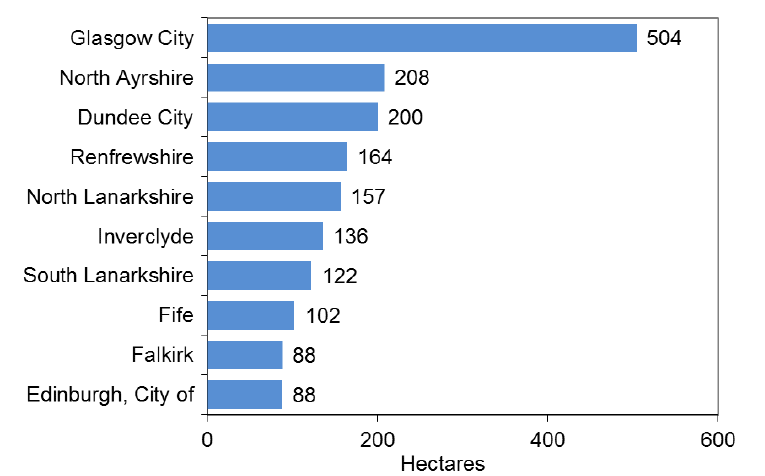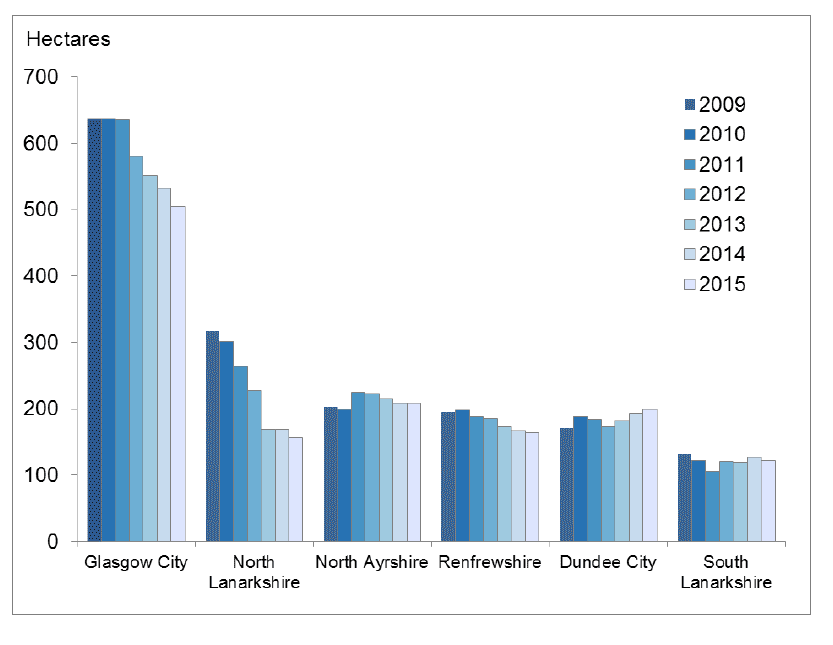Scottish Vacant and Derelict Land Survey 2015
The Scottish Vacant and Derelict Land Survey is a data collection undertaken to establish the extent and state of vacant and derelict land in Scotland. The survey has been operating since 1988, and is managed by the Scottish Government Communities Analysi
8 Urban Vacant Land: Levels and Location
8.1 This section focuses exclusively on urban vacant land, its levels over the past seven years and its location within Scotland. As previously stated, vacant land is land which is unused for the purposes for which it is held and is viewed as an appropriate site for development. The land must either have had prior development on it or preparatory work has taken place in anticipation of future development. Vacant land is described as urban when it is located within settlements of over 2,000 in population. Unlike derelict land, urban vacant land is generally not in need of rehabilitation before new development can commence.
Chart 5: Local Authorities with the largest amount of Urban Vacant Land, 2015

8.2 Table 11 shows the amount of urban vacant land in Scotland, split by local authority for the years 2009-2015. Chart 5 shows the ten councils with the largest amounts of urban vacant land in 2015. There were 2,309 hectares of urban vacant land recorded in Scotland in 2015. Glasgow City has the most urban vacant land with 504 hectares, followed by North Ayrshire (208 hectares) and then Dundee City (200 hectares). In 2015, the largest areas of urban vacant land in Scotland were sites in Redburn, Irvine, North Ayrshire (22 hectares), Claverhouse Business Park, Dundee (22 hectares), the former Inverkip Power Station, Inverclyde (21 hectares) and Orchardbank Business Park, Angus (21 hectares).
8.3 Table 11 shows that in 2009 there were 2,588 hectares of urban vacant land in Scotland. This figure has fallen to a low of 2,309 hectares in 2015. Between 2009 and 2015 there has been an overall 11% (279 hectares) reduction in the amount of urban vacant land in Scotland. A small number of councils did not participate in every survey between 2009 and 2015. In those cases, previous years' data is rolled forward until new data becomes available.
Table 11: Total Urban Vacant Land by local authority area, 2009-2015 1,2,3
| Local Authority | Total Urban Vacant Land Area (ha) | % Change 2009-2015 5 | ||||||
|---|---|---|---|---|---|---|---|---|
| 2009 | 2010 | 2011 | 2012 | 2013 | 2014 | 2015 | ||
| Aberdeen City | 28 | 39 | 30 | 27 | 23 | 22 | 15 | -45% |
| Aberdeenshire | 28 | 28 | 46 | 48 | 40 | 38 | 38 | 34% |
| Angus | 52 | 53 | 50 | 49 | 49 | 57 | 53 | 1% |
| Argyll & Bute 4 | 28 | 21 | 21 | 26 | 25 | 23 | 22 | -20% |
| Clackmannanshire | 21 | 17 | 16 | 10 | 13 | 17 | 16 | -26% |
| Dumfries & Galloway | 14 | 13 | 12 | 8 | 8 | 8 | 6 | -57% |
| Dundee City | 171 | 188 | 184 | 172 | 182 | 194 | 200 | 17% |
| East Ayrshire | 43 | 54 | 53 | 53 | 61 | 55 | 55 | 30% |
| East Dunbartonshire | 14 | 14 | 14 | 12 | 8 | 8 | 8 | -46% |
| East Lothian | 9 | 9 | 9 | 8 | 10 | 10 | 9 | 1% |
| East Renfrewshire | 16 | 17 | 17 | 15 | 21 | 24 | 19 | 16% |
| Edinburgh, City of | 95 | 96 | 97 | 97 | 100 | 97 | 88 | -8% |
| Falkirk | 83 | 81 | 77 | 77 | 82 | 82 | 88 | 7% |
| Fife | 84 | 84 | 88 | 86 | 100 | 99 | 102 | 23% |
| Glasgow City | 636 | 636 | 635 | 581 | 552 | 533 | 504 | -21% |
| Highland | 89 | 81 | 82 | 82 | 80 | 74 | 66 | -26% |
| Inverclyde | 98 | 98 | 98 | 117 | 123 | 120 | 136 | 39% |
| Loch Lomond & the Trossachs 4 | n/a | n/a | 7 | 6 | 6 | 6 | 3 | n/a |
| Midlothian | 20 | 15 | 17 | 17 | 17 | 11 | 11 | -42% |
| Moray | 20 | 24 | 17 | 14 | 12 | 12 | 7 | -66% |
| Na h-Eileanan Siar | 10 | 9 | 9 | 9 | 9 | 9 | 8 | -13% |
| North Ayrshire | 202 | 199 | 225 | 222 | 215 | 209 | 208 | 3% |
| North Lanarkshire | 317 | 301 | 264 | 228 | 169 | 169 | 157 | -51% |
| Orkney Islands | 1 | 1 | 1 | 1 | * | - | - | -100% |
| Perth & Kinross 4 | 11 | 11 | 9 | 9 | 8 | 21 | 20 | 87% |
| Renfrewshire | 195 | 199 | 188 | 185 | 173 | 166 | 164 | -16% |
| Scottish Borders | 30 | 29 | 29 | 31 | 31 | 29 | 29 | -4% |
| Shetland Islands | 3 | 2 | 2 | 2 | 2 | 2 | 1 | -57% |
| South Ayrshire | 14 | 24 | 26 | 29 | 34 | 34 | 34 | 138% |
| South Lanarkshire | 132 | 122 | 105 | 121 | 119 | 127 | 122 | -7% |
| Stirling 4 | 37 | 37 | 40 | 41 | 44 | 34 | 33 | -12% |
| West Dunbartonshire 4 | 24 | 23 | 20 | 20 | 20 | 21 | 15 | -36% |
| West Lothian | 64 | 61 | 61 | 61 | 62 | 72 | 72 | 12% |
| Scotland | 2,588 | 2,586 | 2,550 | 2,463 | 2,397 | 2,379 | 2,309 | -11% |
1. Figures may not sum due to rounding.
2. See Annex Table E for details of council participation in different years.
3. During 2015, historical data for the years 2009-2014 were revised to remove sites that had been taken out of the survey for definitional reasons and to correct any revisions to the data highlighted in the 2015 survey returns. Further information on this process is available in the Annex along with un-amended historical data for the survey years of 1996-2008.
4. From 2011 LLTNP took responsibility for surveying vacant and derelict land within the park boundaries. These sites are no longer recorded in Argyll & Bute, Perth & Kinross, Stirling and West Dunbartonshire local authority boundaries, and are separately identifiable as LLTNP from 2011. Prior to 2011, these sites were classified within the relevant local authority boundary.
5. Previous SVDLS bulletins have used different base years for percentage change and so these percentages should not be compared with those in previous bulletins.
8.4 Changes in the relative amount of urban vacant land in Scotland show greater variation at council level. The largest absolute reduction was seen in North Lanarkshire, down by 160 hectares (51%) from 317 hectares in 2009 to 157 hectares in 2015. Some of the larger percentage changes for certain councils (for example South Ayrshire and Orkney islands) are due to there only being a small base of recorded land in 2009.
8.5 Looking at the 6 councils with the most urban vacant land in 2009, Chart 6 shows the change since 2009 in total levels of urban vacant land. Glasgow City has consistently had the highest amount of urban vacant land in Scotland for the period 2009-2015. Glasgow reported 636 hectares of urban vacant land in 2009, decreasing to 504 hectares (a net decrease of 21%) by 2015. The other three authorities recording percentage decreases are North Lanarkshire (51%), Renfrewshire (16%) and South Lanarkshire (7%). In contrast Dundee City (17%) and North Ayrshire (3%) have seen increases in their level of urban vacant land during the past 6 years.
Chart 6: Total level of Urban Vacant Land in top 6 local authorities (as at 2009), 2009-2015

Contact
There is a problem
Thanks for your feedback